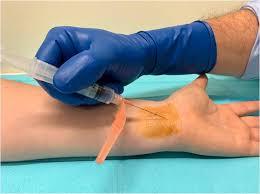Carpal tunnel syndrome (CTS) is one of the most common hand and wrist conditions, affecting millions of people worldwide. When pain, numbness, and tingling begin to impact daily activities, many patients look for fast, effective, and minimally invasive solutions.
Carpal tunnel injections have become a leading option for those who want relief without immediately choosing surgery. In this detailed guide, we explore how the treatment works, what benefits it offers, and who is most likely to experience improvement.
What Is Carpal Tunnel Syndrome?
Carpal tunnel syndrome occurs when the median nerve—running through a narrow passage in the wrist called the carpal tunnel—becomes compressed. This pressure can develop due to repetitive hand movements, inflammatory conditions, pregnancy, or wrist injuries. Symptoms may include:
- Numbness in the thumb, index, and middle fingers
- Tingling or “electric shock” sensations in the hand
- Weak grip strength
- Night-time pain or waking up with numb hands
When symptoms become frequent or severe, many individuals seek non-surgical treatment options as a first step.
Understanding Carpal Tunnel Injections
Carpal tunnel injections typically consist of corticosteroids combined with a local anaesthetic. They are administered directly into the carpal tunnel to reduce inflammation around the median nerve. This targeted approach offers rapid relief, often within days.
These injections are widely used as an intermediate solution between wrist splints and surgery. In many cases, they provide enough symptom improvement to restore normal hand function for months, and sometimes even longer.
How Do Carpal Tunnel Injections Work?
Corticosteroids are powerful anti-inflammatory medications. When delivered directly into the affected tunnel, they reduce swelling in the surrounding tissues. As inflammation decreases, pressure on the median nerve reduces, leading to less pain and numbness.
A typical injection includes:
Corticosteroid – for long-term inflammation control
Local anaesthetic – to provide instant numbing and immediate relief
Ultrasound guidance (optional) – increases precision and effectiveness
Ultrasound-guided procedures have gained popularity as they offer improved accuracy and fewer risks.
Benefits of Carpal Tunnel Injections
Many patients choose carpal tunnel injections because they offer several important benefits:
Fast Pain Relief
Most patients experience immediate numbness relief from the anaesthetic, followed by stronger pain reduction from the steroid within 24–48 hours.
Non-Surgical and Minimally Invasive
For individuals wishing to delay or avoid surgery, injections provide a simple and convenient alternative with minimal downtime.
Improved Hand Function
Reduced nerve pressure allows patients to regain grip strength, coordination, and daily hand mobility.
Cost-Effective Treatment
Compared to surgery, injections are generally more affordable and do not require extended recovery.
Supports Diagnosis
If the injection significantly reduces symptoms, it confirms that the issue is median nerve compression rather than another condition.
Who Is a Good Candidate for Carpal Tunnel Injections?
Healthcare professionals may recommend this treatment for people who:
- Experience moderate to severe pain
- Have persistent symptoms despite splints or rest
- Need rapid relief to continue work or daily activities
- Prefer avoiding or postponing surgery
- Are in early or mid-stages of carpal tunnel syndrome
Patients with advanced CTS or nerve damage may only experience limited benefits and might require surgical intervention.
The Procedure: What to Expect
The injection process is quick, usually taking less than 10 minutes.
Preparation
The wrist is cleaned and sterilised. If using ultrasound, the clinician will locate the median nerve and surrounding structures.
Injection
A fine needle delivers the corticosteroid mixture directly into the carpal tunnel. Most people feel only mild pressure or slight discomfort.
Post-Treatment
Patients can return home immediately. Some may feel temporary soreness, which usually settles within a few hours.
Doctors typically recommend avoiding heavy wrist use for 24 hours after the procedure.
How Long Do Carpal Tunnel Injections Last?
Relief duration varies by individual. On average:
- Many patients experience improvement for 4–6 weeks
- Some enjoy relief for several months
- A smaller number may see permanent improvement
If symptoms return, the healthcare provider may consider repeat injections, though most clinics limit them to a few times per year to avoid tissue weakening.
Risks and Side Effects
Like all medical treatments, carpal tunnel injections have potential risks, though serious complications are rare. Possible side effects include:
- Mild swelling or bruising
- Temporary numbness
- Localised soreness
- Skin thinning at the injection site (rare)
- Temporary increase in symptoms before they improve
Using ultrasound guidance significantly reduces the risk of nerve injury.
Alternative Treatments for Carpal Tunnel Syndrome
If injections offer limited relief or are not suitable, other treatments include:
Conservative Care
- Wrist splints
- Anti-inflammatory medication
- Physiotherapy
- Activity modification
Advanced Options
- Platelet-rich plasma (PRP) therapy
- Radiofrequency ablation
- Surgical release of the carpal tunnel (for severe cases)
Healthcare providers typically tailor the treatment plan based on severity and patient lifestyle.
When to Consider Surgery Instead
Surgery may be necessary when:
- Numbness becomes constant
- Muscle weakness worsens
- Injections provide only short-term relief
- Nerve tests show significant compression
Carpal tunnel release surgery is generally very effective, with high success rates.
Conclusion
Carpal tunnel injections are a reliable, minimally invasive treatment offering fast and effective relief for individuals suffering from carpal tunnel syndrome. They help reduce inflammation, ease pain, restore hand function, and serve as an important step before considering surgery. For many patients, this simple procedure provides months of comfort and the ability to continue daily activities without constant discomfort.
If you are experiencing persistent hand or wrist symptoms, consulting a qualified specialist can help determine whether injections are the right option for you.

